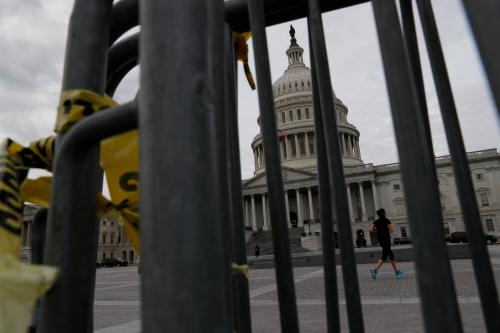As the partial shutdown of the federal government enters its 13th day, the stakes are rising. Shutdowns have numerous negative economic and political effects, but they can be avoided through a simple mechanism, even if the government does not enact a budget.
There are two types of federal spending. Mandatory programs – including Social Security and unemployment insurance – continue in operation until they are changed. By contrast, discretionary programs – such as infrastructure investment, the national park service, public health research, and international assistance – require policymakers to authorize their funding for a set period – typically, but not always, for a year.
But this process frequently breaks down. In most years since 2010, Congress has not even passed a budget resolution that sets overall spending and tax targets. If they cannot agree on a spending bill for the next year, the president and Congress sometimes enact a short-term “continuing resolution” (CR) to fund discretionary programs, typically at the previous year’s levels, until they can agree on new spending. If they don’t pass a spending bill or a CR, the government “shuts down,” though vital services like defense continue.
Lengthy shutdowns took place in 1995-1996, 2013, and now 2018-2019. Altogether, there have been 21 shutdowns, ranging from one day to 21 days.
While the political grandstanding continues, the economy will suffer.
Here’s how we got to the current situation. In September 2018, Congress passed and the president signed appropriations bills for the Legislative Branch, military construction, and the Departments of Defense, Education, Energy, Health and Human Services, and Veterans Affairs.
On December 19, a Republican-controlled Senate passed a CR to fund the rest of the government (albeit only through February 8). But then President Trump said that he would not sign a bill that did not include significant border wall funding, which led to the current stalemate.
The shutdown directly affects the Departments of Agriculture, Commerce, Justice, Homeland Security, Interior, State, Transportation, Treasury, and Housing and Urban Development. As a result, government services ranging from national parks and museums to the IRS and environmental and food inspection offices are experiencing reduced staffing levels, and hundreds of thousands of federal workers are on furlough. (In previous shutdowns, workers have received pay for the time lost.)
Creating a shutdown showdown over the wall seems blatantly political. After all, President Trump and a Republican-controlled Congress had two years to pass a budget that included funding for a wall, but they did not make it a deal-breaker until now. In December, President Trump said he would “own” a shutdown. But then he started blaming the Democrats, even though Republicans controlled both Houses of Congress until the end of 2018.
Politically, the shutdown seems like a litmus test for everything else to come. If political leaders can’t “walk” through the mere process of keeping the government open, how can they ever hope to “run” through more complex issues?
While the political grandstanding continues, the economy will suffer. The frequent failure to ratify a budget in a timely manner breeds uncertainty about whether programs will continue and makes the operation of government programs more difficult.
And shutdowns are expensive: the 2013 shutdown reduced GDP by $24 billion. The confidence-sapping effect on the public was probably far larger. During the 2013 shutdown, 33 percent of Americans cited dissatisfaction with government and elected officials as the nation’s top issue – the highest percentage in Gallup’s history since it began in 1939 – and double the 16 percent figure from the previous month.
If political leaders can’t “walk” through the mere process of keeping the government open, how can they ever hope to “run” through more complex issues?
Moreover, the notion that much of the government should shut down because of disagreements in one tiny area of government spending defies logic and common sense. No business would operate that way. The programs without current funding cost more than $300 billion per year. By contrast, the amount in dispute regarding the wall is roughly $4 billion, after accounting for more than $1 billion of border security funding previously offered by Democrats.
Finally, the shutdown – if it continues – will further reduce any belief that the two parties can get along in the Trump era. If the economy were obviously headed in the right direction, gridlock might be an acceptable outcome. But when major issues – such as fighting a potential recession, dealing with climate change, addressing the opioid crisis, or resolving immigration debates – require active policy changes, gridlock will only make things worse.
To avoid the costs and uncertainties of future government shutdowns, Congress and the president should enact a rule that says that if appropriations bills are not passed on time, a CR that funds the government at the previous year’s inflation-adjusted levels would automatically occur. This would not eliminate gridlock on other issues, but it would take one potential obstacle out of the way, and it would help legislators – even in times of extreme partisanship – meet their most fundamental responsibility – to keep the government open and functioning.
Gale is a senior fellow at the Brookings Institution and author of Fiscal Therapy: Curing America’s Debt Addiction and Investing in the Future (Oxford 2019).
The Brookings Institution is committed to quality, independence, and impact.
We are supported by a diverse array of funders. In line with our values and policies, each Brookings publication represents the sole views of its author(s).





Commentary
How to shut down future shutdowns
January 3, 2019